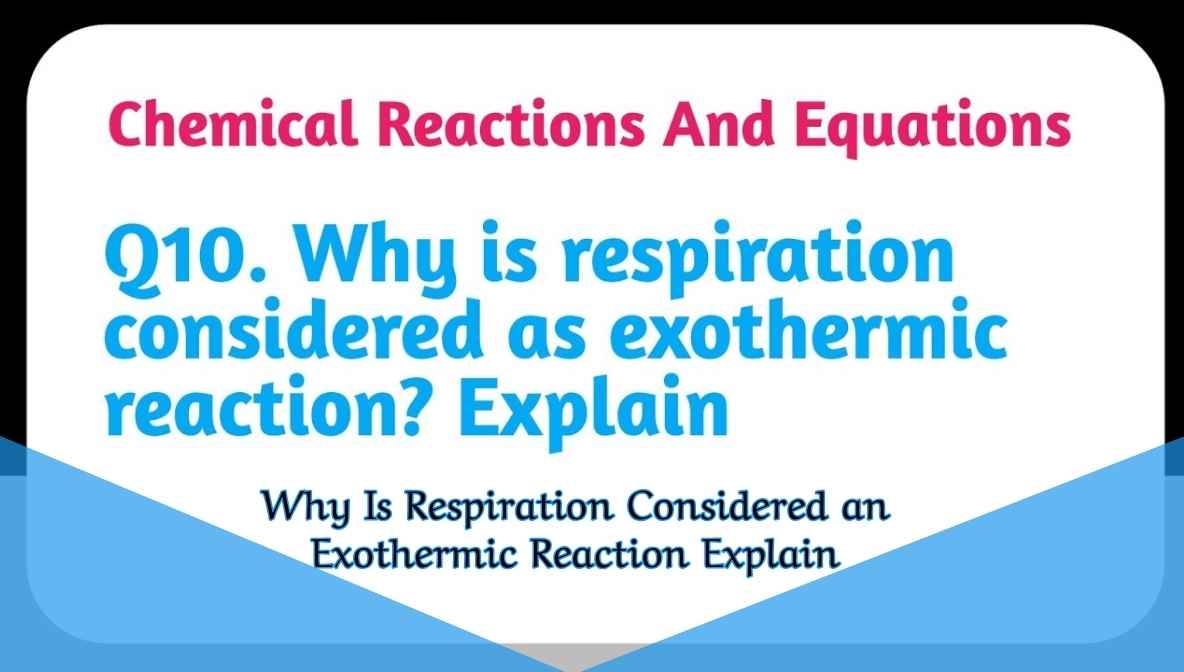
Respiration is a biochemical process of sustaining life in all living cells. It refers to the way how living things generate usable energy by converting glucose (sugar) and oxygen. However, why is a respiration reaction exothermic? To respond to that, we must realize what is going on during respiration at the molecular level and how it is concerned with the release of energy. In lay terms, an exothermic reaction is a reaction that gives out energy in the form of heat. Being a heat and energy releasing process, respiration is considered exothermic.
In this blog post, we are going to put the science behind this, compare it to other types of reactions, and will give concrete examples so that you can understand the same. As a student or someone eager to know more about biology and chemistry, this explanation will help you have a clear picture in a language you will be able to understand, no matter how easy or difficult it is to understand.
Three Key Points:
- Respiration causes glucose to break down, and energy is released.
- This is the release of energy in form of heat and ATP.
- Everything living requires this process to live.
What Is The Meaning Of An Exothermic Reaction?
An exothermic reaction is a chemical reaction which releases energy in most cases as heat or light. The word originated within Greek exo-thermic, which means base and thermic, which means heat. Whenever there is a reaction of the substances, and energy gets emitted to the environment, the surrounding Heats up. This causes the environment to be warm.
Burning wood or lighting a candle are ordinary exothermic reactions, as an example. You can sense the heat oozing of them. In the same way, in chemistry, some reactions contain the release of energy, such as the close of acids and bases or condensation of steam.
Respiration in biology is one of the important exothermic reactions. When our body digests food, particularly glucose, we obtain some energy which is utilized in all the activities of our body like movement as well as thought.
Exothermic reactions Table 1: Characteristics of Exothermic Reactions
| Feature | Description |
|---|---|
| Energy Direction | Released to surroundings |
| Temperature Effect | Increase in surrounding temperature |
| Common Examples | Burning, condensation, neutralization reactions |
| Real-Life Impact | Used in heaters, combustion engines, metabolism |
Note: Not every heat-generating reaction is safe, though (it can be an explosion, depending on energy level).
What is respiration In the human body?
Respiration is whereby the cells in our body receive energy. This occurs when glucose contained in the food we consume reacts with oxygen, which is inhaled. The reaction primarily takes place within the mitochondria, which is the powerhouse of the cell.
The equation for aerobic respiration is:
Glucose (C₆H₁₂O₆) + Oxygen (O₂) → Carbon dioxide (CO₂) + Water (H₂O) + Energy (ATP)
This chemical reaction gives out energy that is in two forms, ATP (Adenosine Triphosphate) and heat. Cells utilize ATP to accomplish their functions, such as muscle contraction, nerve impulses, and digestion. The remaining amount of energy is dissipated in the form of heat, where it balances the body temperature.
When you work out, your body burns some additional glucose, releasing more energy and heat that is why you start sweating or feel warm.
Aerobic vs Anaerobic Respiration Comparison Chart
| Feature | Aerobic Respiration | Anaerobic Respiration |
|---|---|---|
| Oxygen Required | Yes | No |
| Energy Produced | More (38 ATP) | Less (2 ATP) |
| End Products | CO₂, H₂O | Lactic acid or ethanol |
| Occurs In | Most plants & animals | Yeast, muscles (temporarily) |
Note: Aerobic breathing provides your body with greater energy than anaerobic which is why your body chooses to undergo the former.
Why is Respiration a Classified An Exothermic Reaction?
One must classify respiration as an exothermic reaction since it involves giving out energy when it reduces glucose. This energy does not only stored in the form of ATP, but also this energy is also released as heat, this heat raises the temperature of other cells that are around.
We will take up a simple example. As you rapidly rub your hands together, they get warm. In the same light, once you have food that is digested by your body, it emits heat. The exothermic nature of respiration has to do with that warmth.
Chemically, the bond of glucose is divided and a bond is created in carbon dioxide and water. The energy required to separate bonds is smaller than the energy given out when new bonds are formed- the additional energy is the one we experience as heat.
Therefore, when glucose in the presence of oxygen reacts, the energy liberated is more as compared to that required, hence the overall reaction is energy-liberating or exothermic.
What Is The Role Of Heat In The Cellular Respiration?
Heat related to cellular respiration is important in the body in order to maintain the internal temperature of the body. Lack of such a heated phenomenon would lead to cooling body to cold easily, particularly in low temperature areas.
The body temperature of warm-blooded animals like human beings should be stable in order to ensure that enzymes and other biological activities are effectively performed. This internal condition, which is vital to survival, gets aided in regulation by the heat produced during respiration.
Think of a winter day, and it is cold. The body uses breathing to produce heat even when you are not doing anything. It is by this means that your body is kept warm. Without exothermic respiration, we would always have to rely on some external sources to keep us warm.
Is There a Condition in which Respiration can be Endothermic?
No, in living things, normal respiration never takes place under endothermic conditions. Endothermic reactions take up heat around them. Respiration works in the opposite direction; it produces heat.
In biology and chemistry, there are endothermic reactions, such as photosynthesis. During photosynthesis, plants take in sunlight (source of energy) in order to change carbon dioxide and water into glucose. This is an energy storing process as compared to respiration, which is the energy releasing process.
But certain experimental or man-made conditions, such as laboratory simulation, may attempt to generate uncoupled reactions that seem to work backward, but such reactions need an energy source, and that is no longer normal respiration.
Table 2: Respiration Vs Photosynthesis
| Feature | Respiration | Photosynthesis |
|---|---|---|
| Type of Reaction | Exothermic | Endothermic |
| Energy Flow | Releases energy | Absorbs light energy |
| Products | CO₂ + H₂O | Glucose + O₂ |
| Occurs In | All living cells | Green plant cells (chloroplasts) |
Conclusion
Conclusively, it is apparent that the process of respiration is an exothermic reaction as it gives out energy as glucose is broken down in the existence of oxygen. Part of this energy is conserved in the form of ATP, and the remainder is dissipated as heat. Without such heat, our bodies would not be able to operate as they normally do, and life could not carry on as we know it.
As a scientist or real-life observer, respiration obviously has a clear label of an exothermic process. Learning this is not just useful when taking school tests, but also makes you know more about how nature and our bodies act on a molecular scale.
Bear in mind that without this exothermic magic going on in us, we should not be able to move, think, or even keep ourselves warm!
FAQ’s
1. Why would respiration be described as an exothermic reaction?
Because it liberates energy in the shape of warmth and ATP as glucose is smashed.
2. What can be cited as an instance of an exothermic reaction in everyday life?
When you strike a match or a bonfire, you automatically liberate heat.
3. Does anaerobic respiration give out heat as well?
Yes, with less energy and heat than aerobic respiration.
4. Is it ever possible to have an endothermic respiration?
No, respiration is always exothermic; it gives out energy.
5. What do aerobic respiration products occur?
Energy (ATP + heat), water, and carbon dioxide.






![Is Wellbutrin Good for Anxiety? 7 Must-Know Facts [2025 Guide]](https://mp4moviez2.co.in/wp-content/uploads/2025/07/is-wellbutrin-good-for-anxiety.jpg)
![Beta Blockers for Anxiety: 7 Essential Benefits [2025 Guide]](https://mp4moviez2.co.in/wp-content/uploads/2025/07/beta-blockers-for-anxiety.jpg)